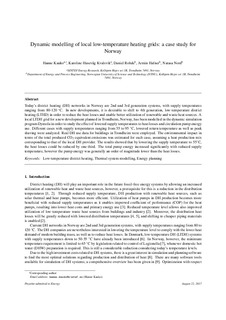| dc.contributor.author | Kauko, Hanne | |
| dc.contributor.author | Kvalsvik, Karoline Husevåg | |
| dc.contributor.author | Rohde, Daniel | |
| dc.contributor.author | Hafner, Armin | |
| dc.contributor.author | Nord, Natasa | |
| dc.date.accessioned | 2019-09-20T11:50:25Z | |
| dc.date.available | 2019-09-20T11:50:25Z | |
| dc.date.created | 2017-08-22T11:22:36Z | |
| dc.date.issued | 2017 | |
| dc.identifier.citation | Energy. 2017, 139 289-297. | nb_NO |
| dc.identifier.issn | 0360-5442 | |
| dc.identifier.uri | http://hdl.handle.net/11250/2618033 | |
| dc.description.abstract | Today's district heating (DH) networks in Norway are 2nd and 3rd generation systems, with supply temperatures ranging from 80 to 120 °C. In new developments, it is desirable to shift to 4th generation, low-temperature district heating (LTHD) in order to reduce the heat losses and enable better utilization of renewable and waste heat sources. A local LTDH grid for a new development planned in Trondheim, Norway, has been modelled in the dynamic simulation program Dymola in order to study the effect of lowered supply temperatures to heat losses and circulation pump energy use. Different scenarios with supply temperatures ranging from 55 to 95 °C, lowered return temperature as well as peak shaving were analyzed. Real DH use data for buildings in Trondheim were employed. The environmental impact in terms of the total produced CO2equivalent emissions was estimated for each scenario, assuming a heat production mix corresponding to that of the local DH provider. The results showed that by lowering the supply temperature to 55 °C, the heat losses could be reduced by one third. The total pump energy increased significantly with reduced supply temperature, however the pump energy was generally an order of magnitude lower than the heat losses. © 2017 Elsevier Ltd | nb_NO |
| dc.language.iso | eng | nb_NO |
| dc.publisher | Elsevier | nb_NO |
| dc.rights | Attribution-NonCommercial-NoDerivatives 4.0 Internasjonal | * |
| dc.rights.uri | http://creativecommons.org/licenses/by-nc-nd/4.0/deed.no | * |
| dc.title | Dynamic modelling of local low-temperature heating grids: A case study for Norway | nb_NO |
| dc.type | Journal article | nb_NO |
| dc.type | Peer reviewed | nb_NO |
| dc.description.version | acceptedVersion | nb_NO |
| dc.source.pagenumber | 289-297 | nb_NO |
| dc.source.volume | 139 | nb_NO |
| dc.source.journal | Energy | nb_NO |
| dc.identifier.doi | 10.1016/j.energy.2017.07.086 | |
| dc.identifier.cristin | 1487829 | |
| dc.relation.project | Norges forskningsråd: 245355 | nb_NO |
| cristin.unitcode | 7548,70,0,0 | |
| cristin.unitname | Termisk energi | |
| cristin.ispublished | true | |
| cristin.fulltext | postprint | |
| cristin.qualitycode | 2 | |

